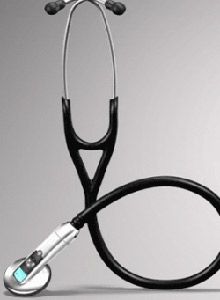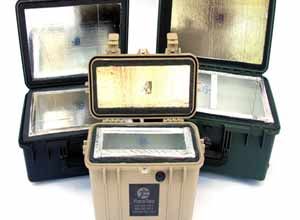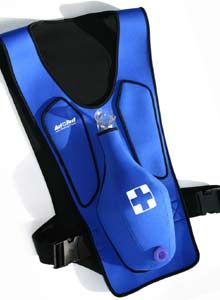By Scott M. Bruner
EMS1.com Product Editor
Each year, countless new products debut with the aim of improving EMS quality of care and capabilities, and 2009 was no different. As the leading online product resource for EMS, we are privy to many of these new products, and some catch our attention immediately. Here are five innovative products we believe made a significant contribution to the EMS community in 2009:
 Photo courtesy 3M |
1) 3M‘s Littmann Electronic Stethoscope Model 3200
Taking the stethoscope into the 21st century, the 3M Littmann Electronic Stethoscope Model 3200 is a next-generation auscultation device featuring Bluetooth technology that wirelessly transfers heart, lung and other body sounds to software for further analysis.
The 3200 comes paired with Zargis SethAssist software – and can also be upgraded to Zargis Cardioscan software – in order to identify systolic or diastolic heart murmurs. Recordings are electronically stored and can be used for a second opinion.
According to a retrospective study published in Clinical Cardiology in 2008, physicians using Cardioscan results reduced their false negative referral decisions for heart murmurs by an average of 46 percent and reduced their unnecessary referral decisions by an average of 41 percent.
The 3200 features 24x sound amplification and proprietary Ambient Noise Reduction (ANR) Technology, which reduces, on average, 85 percent of ambient noise that can interfere with the auscultation experience.
2) The ViVre Medical LifeGuard30
ViVre Medical’s Lifeguard30 is one of the newest tools helping consumers to arm themselves with information that may potentially save their life in an emergency. Lifeguard30 is a system designed to help ensure critical medical information is available to emergency medical service professionals in situations where patients are unable to speak for themselves.
The LifeGuard30 is a complete system that provides the storage and transportation of medical information to be used at the scene of an emergency while accessing the health of a patient. The Lifeguard digitally confirms the patient’s identity, medications, allergies, medical conditions, emergency contacts and much more – all on a digital screen. The LG30 is equipped with the exclusive LifeSupport system that ensures the patient’s medical information is accessible even when the device is damaged, missing or inoperable.
Lifeguard30 provides the owner up-to-date emergency medical information on the spot without a phone, computer or internet access.
3) FareTec LifeBox 50
FareTec’s LifeBox50 is one of the most reliable and cost-effective methods for transporting temperature sensitive supplies to save lives. The LifeBox50 is specifically designed to keep sensitive fluid at temperature for up to 50 hours, and beyond depending on conditions.
 Photo courtesy Fare-Tec |
It uses a carbon-based nanotechnology to create an insulation factor of R50. The containers have demonstrated unprecedented thermal insulation. The vacuum-insulated panels have proven to maintain an environment between 2-8 degrees Celsius for more than 50 hours with only two pounds of frozen gel packs.
The LifeBox50 is specifically designed for temporary, sensitive medications, hot or cold transportation of fluid, cold therapy, and for rapid response during the critical Golden Hour.
The LifeBox50 can be customized in several sizes, is lightweight, and is also offered in a hard case version. With the LifeBox50 there is no longer a need for expensive, large, “powered units” for refrigeration – it’s reusable and easy to clean, there is no tether to a power supply, and the LifeBox50’s price tag is extremely reasonable.
4) Vidacare’s EZ-IO Intraosseous Infusion System
Vidacare’s EZ-IO Intraosseous Infusion System is a complete solution for immediate vascular access in patients larger than 3 kg. Used an estimated 350,000 times across the world the EZ-IO is the leading choice for intraosseous access in all care, from the ambulance to the hospital, to the battlefield and beyond. The EZ-IO system is designed to help the medical professional gain vascular access to provide intravenous therapy. It’s extremely easy to use, train and maintain.
The EZ-IO allows emergency personnel to gain immediate vascular access when they need it most. In emergency situations — when IV access is difficult and time consuming — EZ-IO provides safe, simple, and rapid vascular access through the intraosseous space. EZ-IO can be used to establish stable and secure vascular access in less than 10 seconds — for both alert and unconscious children and adults. Once established, the EZ-IO line remains stable during transport and can be used to deliver drugs, fluids, or blood products required for treatment.
5) The Act Fast Anti-Choking Trainer Vest
 Photo courtesy Act Fast |
The Act Fast Choking Rescue Trainer is a lightweight neoprene vest worn by students that allows teaching of the Abdominal Thrust Maneuver in a variety of realistic scenarios. Originally developed by Dr. Timothy Adams to help train Boy Scouts in the rescue of choking victims, the trainer has quickly become a hit in CPR classes in California.
When correct hand placement and technique are used, a soft foam plug shoots dramatically from the trainer, instantly providing strong visual feedback that encourages information retention in students.The vest not only makes teaching easy, it also makes CPR instruction enjoyable. The Trainer is very durable and machine washable. It comes complete with a removable instruction card that can be placed in a clear plastic pocket on the back of the vest to aid in teaching the Abdominal Thrust Maneuver. In addition, the red trainer features a Back Blow Pad for practicing ARC and ERC protocols.
As 2009 draws to a close, we are excited about these and other advances in technology for the EMS community, and expect 2010 to offer its own rewards and innovations. Check back next year for more EMS1 product news.










